Analysis of Amazon's Digital Marketing Strategies and Connected Spaces
VerifiedAdded on 2021/04/24
|6
|1394
|111
Essay
AI Summary
This essay examines Amazon's digital marketing strategies in the context of the connected spaces. It highlights the increasing reliance on digital marketing due to its cost-effectiveness and targeted reach. The essay identifies issues such as intrusive advertising and misleading promotions that negatively impact the consumer experience. It also explores the importance of integrating online and offline campaigns for optimal results, using examples of how Amazon integrates its TV commercials and offline activities with its digital marketing efforts. The essay emphasizes the need for companies to streamline their strategies to maximize consumer benefit and adapt to the evolving digital landscape. The author discusses the importance of digital marketing and the need to make it more consumer-friendly.
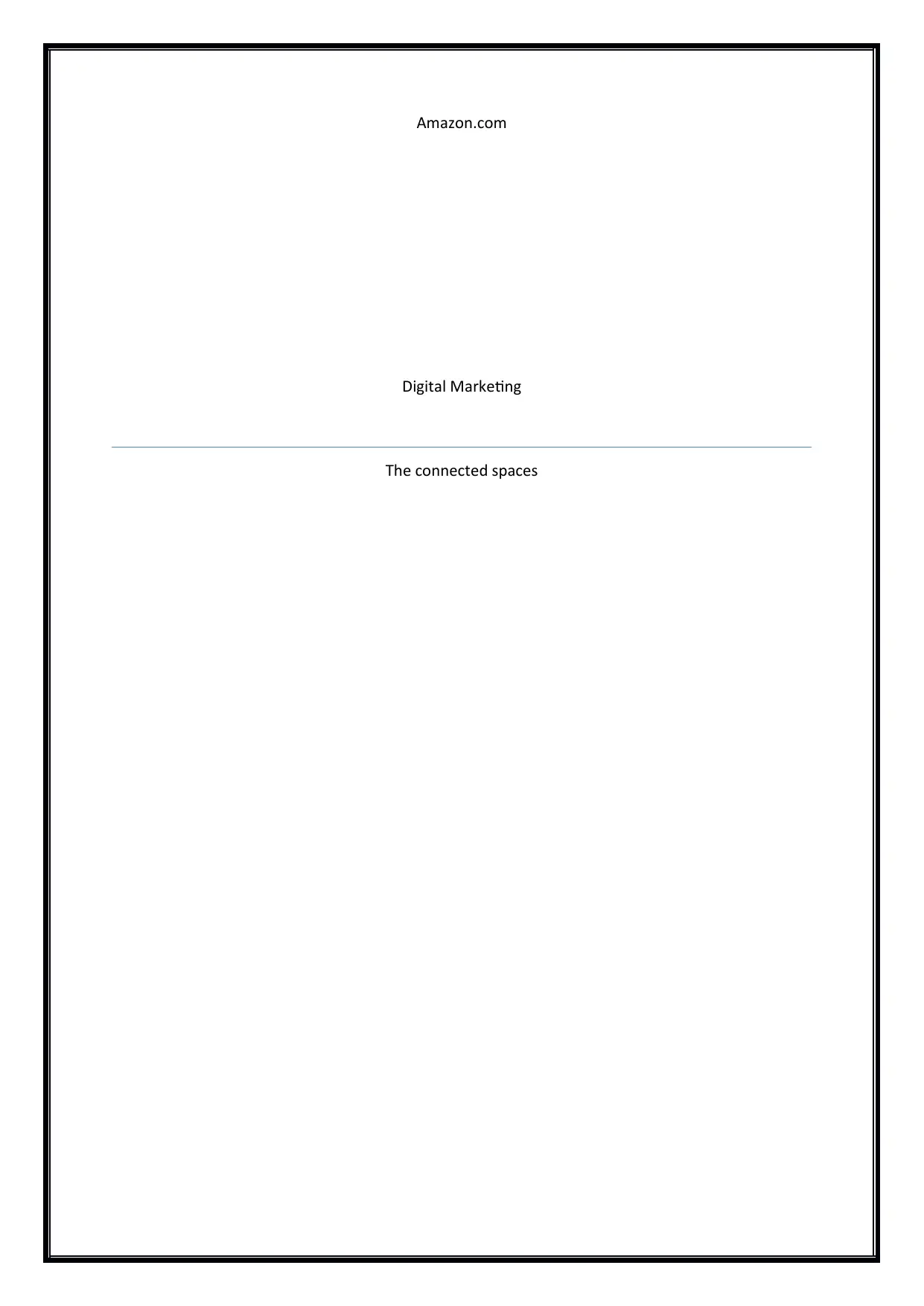
Amazon.com
Digital Marketing
The connected spaces
Digital Marketing
The connected spaces
Paraphrase This Document
Need a fresh take? Get an instant paraphrase of this document with our AI Paraphraser
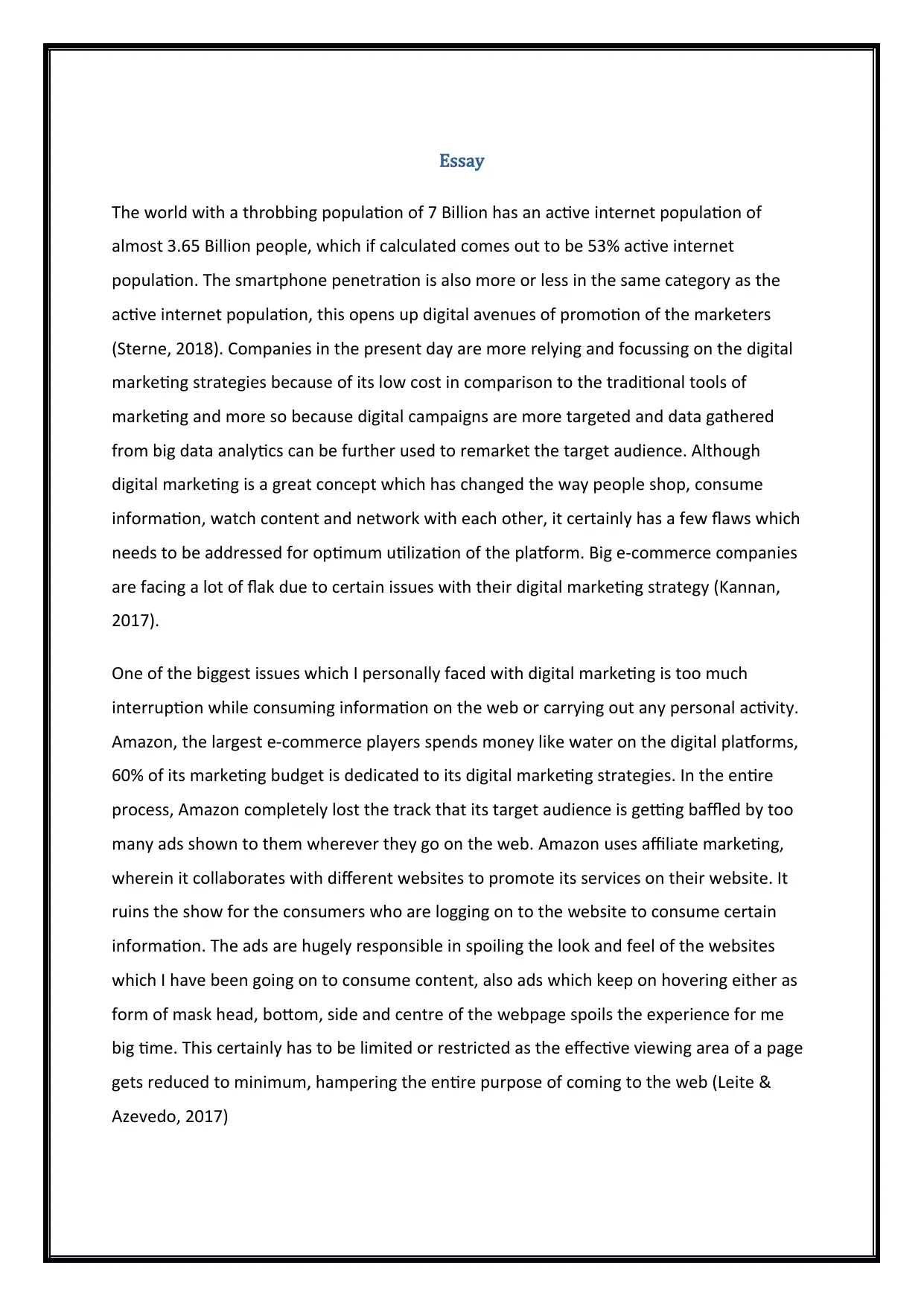
Essay
The world with a throbbing population of 7 Billion has an active internet population of
almost 3.65 Billion people, which if calculated comes out to be 53% active internet
population. The smartphone penetration is also more or less in the same category as the
active internet population, this opens up digital avenues of promotion of the marketers
(Sterne, 2018). Companies in the present day are more relying and focussing on the digital
marketing strategies because of its low cost in comparison to the traditional tools of
marketing and more so because digital campaigns are more targeted and data gathered
from big data analytics can be further used to remarket the target audience. Although
digital marketing is a great concept which has changed the way people shop, consume
information, watch content and network with each other, it certainly has a few flaws which
needs to be addressed for optimum utilization of the platform. Big e-commerce companies
are facing a lot of flak due to certain issues with their digital marketing strategy (Kannan,
2017).
One of the biggest issues which I personally faced with digital marketing is too much
interruption while consuming information on the web or carrying out any personal activity.
Amazon, the largest e-commerce players spends money like water on the digital platforms,
60% of its marketing budget is dedicated to its digital marketing strategies. In the entire
process, Amazon completely lost the track that its target audience is getting baffled by too
many ads shown to them wherever they go on the web. Amazon uses affiliate marketing,
wherein it collaborates with different websites to promote its services on their website. It
ruins the show for the consumers who are logging on to the website to consume certain
information. The ads are hugely responsible in spoiling the look and feel of the websites
which I have been going on to consume content, also ads which keep on hovering either as
form of mask head, bottom, side and centre of the webpage spoils the experience for me
big time. This certainly has to be limited or restricted as the effective viewing area of a page
gets reduced to minimum, hampering the entire purpose of coming to the web (Leite &
Azevedo, 2017)
The world with a throbbing population of 7 Billion has an active internet population of
almost 3.65 Billion people, which if calculated comes out to be 53% active internet
population. The smartphone penetration is also more or less in the same category as the
active internet population, this opens up digital avenues of promotion of the marketers
(Sterne, 2018). Companies in the present day are more relying and focussing on the digital
marketing strategies because of its low cost in comparison to the traditional tools of
marketing and more so because digital campaigns are more targeted and data gathered
from big data analytics can be further used to remarket the target audience. Although
digital marketing is a great concept which has changed the way people shop, consume
information, watch content and network with each other, it certainly has a few flaws which
needs to be addressed for optimum utilization of the platform. Big e-commerce companies
are facing a lot of flak due to certain issues with their digital marketing strategy (Kannan,
2017).
One of the biggest issues which I personally faced with digital marketing is too much
interruption while consuming information on the web or carrying out any personal activity.
Amazon, the largest e-commerce players spends money like water on the digital platforms,
60% of its marketing budget is dedicated to its digital marketing strategies. In the entire
process, Amazon completely lost the track that its target audience is getting baffled by too
many ads shown to them wherever they go on the web. Amazon uses affiliate marketing,
wherein it collaborates with different websites to promote its services on their website. It
ruins the show for the consumers who are logging on to the website to consume certain
information. The ads are hugely responsible in spoiling the look and feel of the websites
which I have been going on to consume content, also ads which keep on hovering either as
form of mask head, bottom, side and centre of the webpage spoils the experience for me
big time. This certainly has to be limited or restricted as the effective viewing area of a page
gets reduced to minimum, hampering the entire purpose of coming to the web (Leite &
Azevedo, 2017)
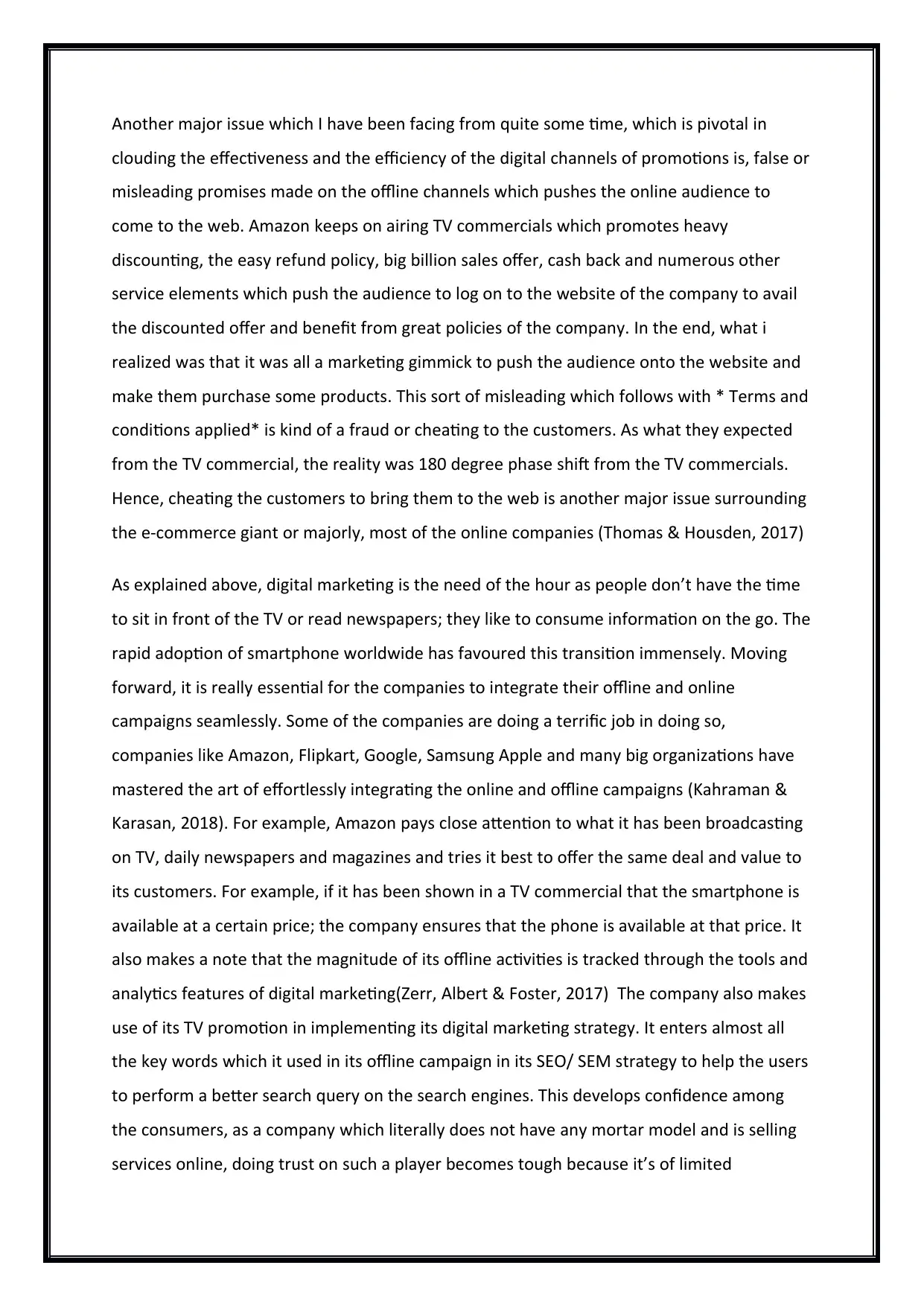
Another major issue which I have been facing from quite some time, which is pivotal in
clouding the effectiveness and the efficiency of the digital channels of promotions is, false or
misleading promises made on the offline channels which pushes the online audience to
come to the web. Amazon keeps on airing TV commercials which promotes heavy
discounting, the easy refund policy, big billion sales offer, cash back and numerous other
service elements which push the audience to log on to the website of the company to avail
the discounted offer and benefit from great policies of the company. In the end, what i
realized was that it was all a marketing gimmick to push the audience onto the website and
make them purchase some products. This sort of misleading which follows with * Terms and
conditions applied* is kind of a fraud or cheating to the customers. As what they expected
from the TV commercial, the reality was 180 degree phase shift from the TV commercials.
Hence, cheating the customers to bring them to the web is another major issue surrounding
the e-commerce giant or majorly, most of the online companies (Thomas & Housden, 2017)
As explained above, digital marketing is the need of the hour as people don’t have the time
to sit in front of the TV or read newspapers; they like to consume information on the go. The
rapid adoption of smartphone worldwide has favoured this transition immensely. Moving
forward, it is really essential for the companies to integrate their offline and online
campaigns seamlessly. Some of the companies are doing a terrific job in doing so,
companies like Amazon, Flipkart, Google, Samsung Apple and many big organizations have
mastered the art of effortlessly integrating the online and offline campaigns (Kahraman &
Karasan, 2018). For example, Amazon pays close attention to what it has been broadcasting
on TV, daily newspapers and magazines and tries it best to offer the same deal and value to
its customers. For example, if it has been shown in a TV commercial that the smartphone is
available at a certain price; the company ensures that the phone is available at that price. It
also makes a note that the magnitude of its offline activities is tracked through the tools and
analytics features of digital marketing(Zerr, Albert & Foster, 2017) The company also makes
use of its TV promotion in implementing its digital marketing strategy. It enters almost all
the key words which it used in its offline campaign in its SEO/ SEM strategy to help the users
to perform a better search query on the search engines. This develops confidence among
the consumers, as a company which literally does not have any mortar model and is selling
services online, doing trust on such a player becomes tough because it’s of limited
clouding the effectiveness and the efficiency of the digital channels of promotions is, false or
misleading promises made on the offline channels which pushes the online audience to
come to the web. Amazon keeps on airing TV commercials which promotes heavy
discounting, the easy refund policy, big billion sales offer, cash back and numerous other
service elements which push the audience to log on to the website of the company to avail
the discounted offer and benefit from great policies of the company. In the end, what i
realized was that it was all a marketing gimmick to push the audience onto the website and
make them purchase some products. This sort of misleading which follows with * Terms and
conditions applied* is kind of a fraud or cheating to the customers. As what they expected
from the TV commercial, the reality was 180 degree phase shift from the TV commercials.
Hence, cheating the customers to bring them to the web is another major issue surrounding
the e-commerce giant or majorly, most of the online companies (Thomas & Housden, 2017)
As explained above, digital marketing is the need of the hour as people don’t have the time
to sit in front of the TV or read newspapers; they like to consume information on the go. The
rapid adoption of smartphone worldwide has favoured this transition immensely. Moving
forward, it is really essential for the companies to integrate their offline and online
campaigns seamlessly. Some of the companies are doing a terrific job in doing so,
companies like Amazon, Flipkart, Google, Samsung Apple and many big organizations have
mastered the art of effortlessly integrating the online and offline campaigns (Kahraman &
Karasan, 2018). For example, Amazon pays close attention to what it has been broadcasting
on TV, daily newspapers and magazines and tries it best to offer the same deal and value to
its customers. For example, if it has been shown in a TV commercial that the smartphone is
available at a certain price; the company ensures that the phone is available at that price. It
also makes a note that the magnitude of its offline activities is tracked through the tools and
analytics features of digital marketing(Zerr, Albert & Foster, 2017) The company also makes
use of its TV promotion in implementing its digital marketing strategy. It enters almost all
the key words which it used in its offline campaign in its SEO/ SEM strategy to help the users
to perform a better search query on the search engines. This develops confidence among
the consumers, as a company which literally does not have any mortar model and is selling
services online, doing trust on such a player becomes tough because it’s of limited
⊘ This is a preview!⊘
Do you want full access?
Subscribe today to unlock all pages.

Trusted by 1+ million students worldwide
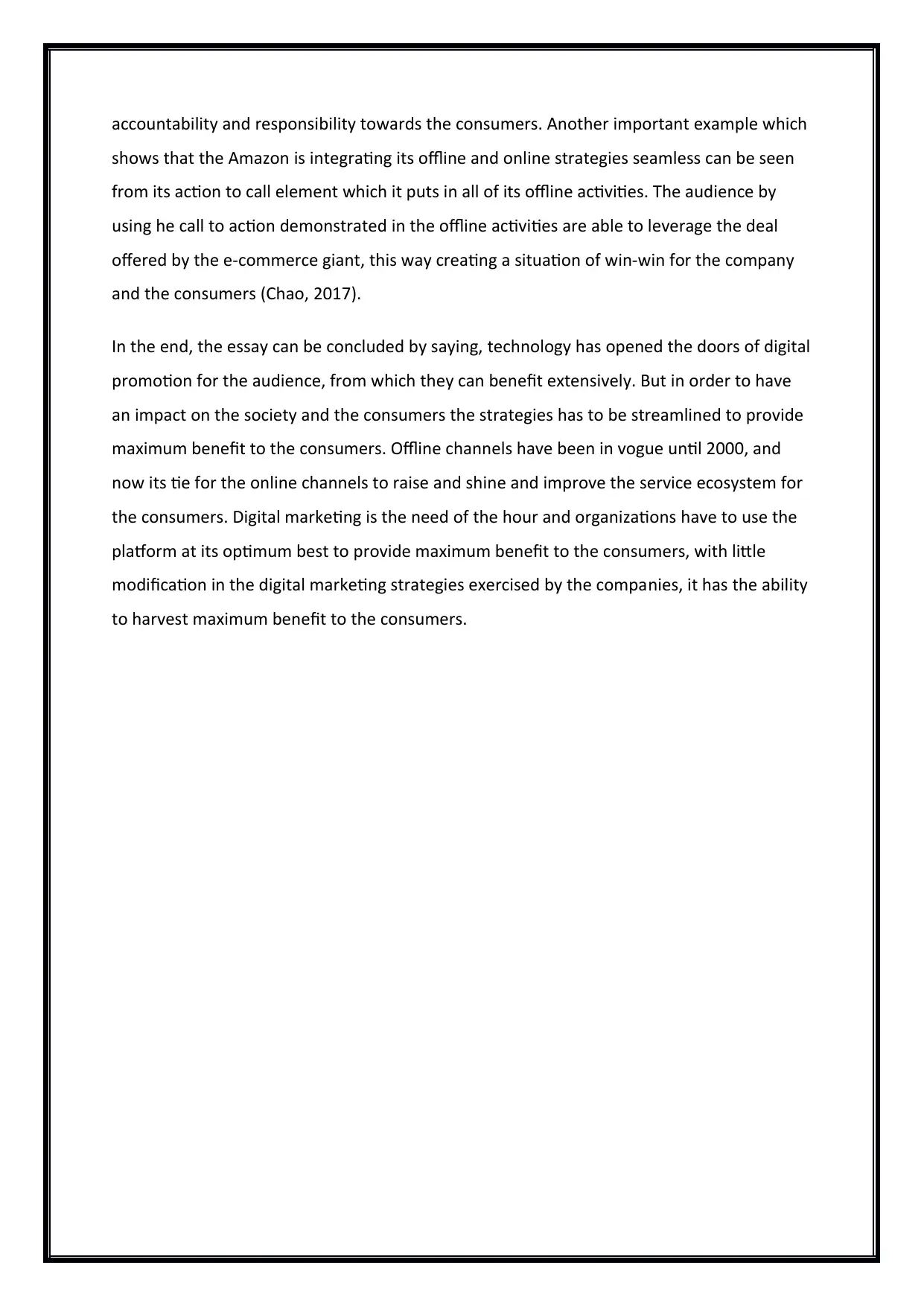
accountability and responsibility towards the consumers. Another important example which
shows that the Amazon is integrating its offline and online strategies seamless can be seen
from its action to call element which it puts in all of its offline activities. The audience by
using he call to action demonstrated in the offline activities are able to leverage the deal
offered by the e-commerce giant, this way creating a situation of win-win for the company
and the consumers (Chao, 2017).
In the end, the essay can be concluded by saying, technology has opened the doors of digital
promotion for the audience, from which they can benefit extensively. But in order to have
an impact on the society and the consumers the strategies has to be streamlined to provide
maximum benefit to the consumers. Offline channels have been in vogue until 2000, and
now its tie for the online channels to raise and shine and improve the service ecosystem for
the consumers. Digital marketing is the need of the hour and organizations have to use the
platform at its optimum best to provide maximum benefit to the consumers, with little
modification in the digital marketing strategies exercised by the companies, it has the ability
to harvest maximum benefit to the consumers.
shows that the Amazon is integrating its offline and online strategies seamless can be seen
from its action to call element which it puts in all of its offline activities. The audience by
using he call to action demonstrated in the offline activities are able to leverage the deal
offered by the e-commerce giant, this way creating a situation of win-win for the company
and the consumers (Chao, 2017).
In the end, the essay can be concluded by saying, technology has opened the doors of digital
promotion for the audience, from which they can benefit extensively. But in order to have
an impact on the society and the consumers the strategies has to be streamlined to provide
maximum benefit to the consumers. Offline channels have been in vogue until 2000, and
now its tie for the online channels to raise and shine and improve the service ecosystem for
the consumers. Digital marketing is the need of the hour and organizations have to use the
platform at its optimum best to provide maximum benefit to the consumers, with little
modification in the digital marketing strategies exercised by the companies, it has the ability
to harvest maximum benefit to the consumers.
Paraphrase This Document
Need a fresh take? Get an instant paraphrase of this document with our AI Paraphraser

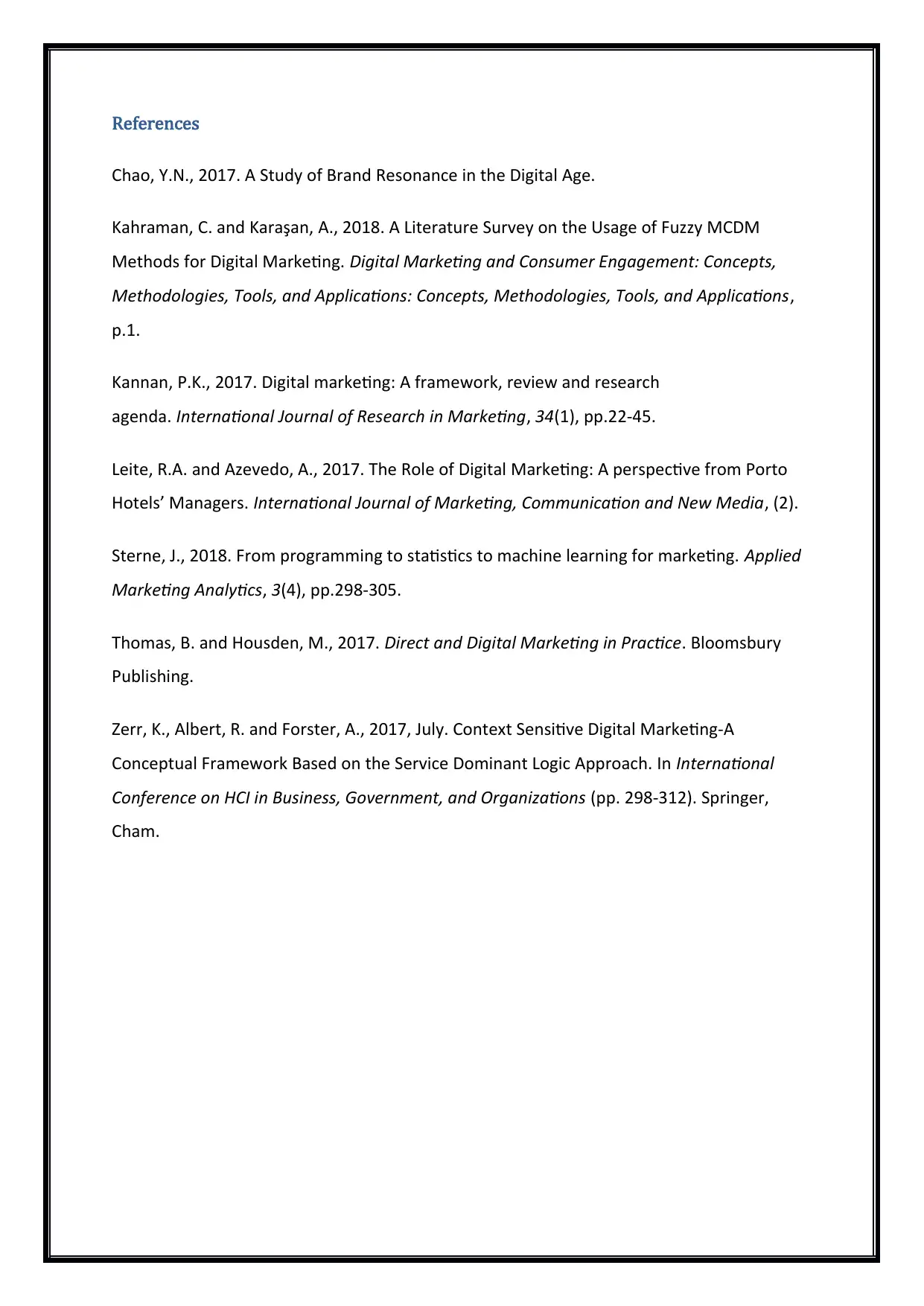
References
Chao, Y.N., 2017. A Study of Brand Resonance in the Digital Age.
Kahraman, C. and Karaşan, A., 2018. A Literature Survey on the Usage of Fuzzy MCDM
Methods for Digital Marketing. Digital Marketing and Consumer Engagement: Concepts,
Methodologies, Tools, and Applications: Concepts, Methodologies, Tools, and Applications,
p.1.
Kannan, P.K., 2017. Digital marketing: A framework, review and research
agenda. International Journal of Research in Marketing, 34(1), pp.22-45.
Leite, R.A. and Azevedo, A., 2017. The Role of Digital Marketing: A perspective from Porto
Hotels’ Managers. International Journal of Marketing, Communication and New Media, (2).
Sterne, J., 2018. From programming to statistics to machine learning for marketing. Applied
Marketing Analytics, 3(4), pp.298-305.
Thomas, B. and Housden, M., 2017. Direct and Digital Marketing in Practice. Bloomsbury
Publishing.
Zerr, K., Albert, R. and Forster, A., 2017, July. Context Sensitive Digital Marketing-A
Conceptual Framework Based on the Service Dominant Logic Approach. In International
Conference on HCI in Business, Government, and Organizations (pp. 298-312). Springer,
Cham.
Chao, Y.N., 2017. A Study of Brand Resonance in the Digital Age.
Kahraman, C. and Karaşan, A., 2018. A Literature Survey on the Usage of Fuzzy MCDM
Methods for Digital Marketing. Digital Marketing and Consumer Engagement: Concepts,
Methodologies, Tools, and Applications: Concepts, Methodologies, Tools, and Applications,
p.1.
Kannan, P.K., 2017. Digital marketing: A framework, review and research
agenda. International Journal of Research in Marketing, 34(1), pp.22-45.
Leite, R.A. and Azevedo, A., 2017. The Role of Digital Marketing: A perspective from Porto
Hotels’ Managers. International Journal of Marketing, Communication and New Media, (2).
Sterne, J., 2018. From programming to statistics to machine learning for marketing. Applied
Marketing Analytics, 3(4), pp.298-305.
Thomas, B. and Housden, M., 2017. Direct and Digital Marketing in Practice. Bloomsbury
Publishing.
Zerr, K., Albert, R. and Forster, A., 2017, July. Context Sensitive Digital Marketing-A
Conceptual Framework Based on the Service Dominant Logic Approach. In International
Conference on HCI in Business, Government, and Organizations (pp. 298-312). Springer,
Cham.
⊘ This is a preview!⊘
Do you want full access?
Subscribe today to unlock all pages.

Trusted by 1+ million students worldwide
1 out of 6
Related Documents
Your All-in-One AI-Powered Toolkit for Academic Success.
+13062052269
info@desklib.com
Available 24*7 on WhatsApp / Email
![[object Object]](/_next/static/media/star-bottom.7253800d.svg)
Unlock your academic potential
Copyright © 2020–2025 A2Z Services. All Rights Reserved. Developed and managed by ZUCOL.





